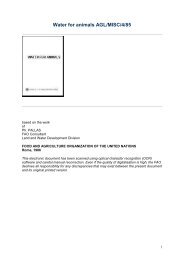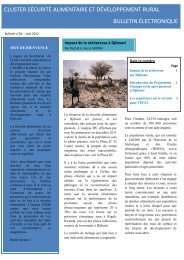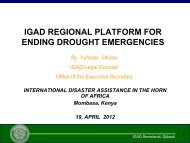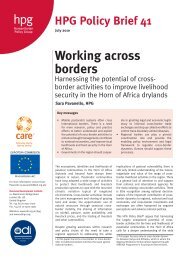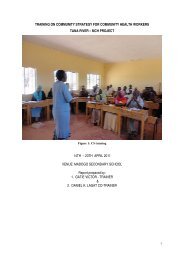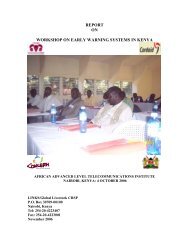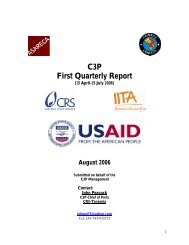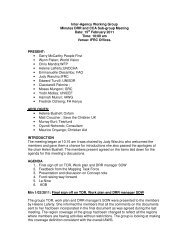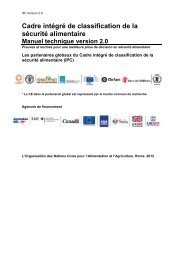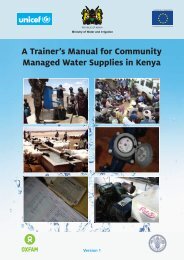• Improving underst<str<strong>on</strong>g>and</str<strong>on</strong>g>ing <str<strong>on</strong>g>of</str<strong>on</strong>g> social dynamics in pastoral areas <str<strong>on</strong>g>and</str<strong>on</strong>g> streng<strong>the</strong>ning communityparticipati<strong>on</strong>.• Financing small water schemes such as h<str<strong>on</strong>g>and</str<strong>on</strong>g> dug wells, shallow wells fitted with h<str<strong>on</strong>g>and</str<strong>on</strong>g> pumps,p<strong>on</strong>ds, birkado <str<strong>on</strong>g>and</str<strong>on</strong>g> hafir dams, because <strong>the</strong> negative aspects <str<strong>on</strong>g>of</str<strong>on</strong>g> large-capacity waterdevelopments have been identified (including a tendency towards settlement <str<strong>on</strong>g>and</str<strong>on</strong>g> pasturedegradati<strong>on</strong>).• Awareness that management <str<strong>on</strong>g>and</str<strong>on</strong>g> ownership c<strong>on</strong>cerns include <strong>the</strong> risk <str<strong>on</strong>g>of</str<strong>on</strong>g> c<strong>on</strong>trol by <strong>on</strong>ecommunity over a large source <str<strong>on</strong>g>of</str<strong>on</strong>g> water, leading to exclusi<strong>on</strong> or inequity within communities<str<strong>on</strong>g>and</str<strong>on</strong>g> increased potential for c<strong>on</strong>flict.• Awareness that technical c<strong>on</strong>cerns include <strong>the</strong> lack <str<strong>on</strong>g>of</str<strong>on</strong>g> financial <str<strong>on</strong>g>and</str<strong>on</strong>g> technical capacity atcommunity level to operate <strong>the</strong>se schemes, requiring more focus <strong>on</strong> training <str<strong>on</strong>g>and</str<strong>on</strong>g> capacitybuilding.• Increased focus <strong>on</strong> measuring social impact <str<strong>on</strong>g>and</str<strong>on</strong>g> impacts <strong>on</strong> livelihoods.• Establishing a Regi<strong>on</strong>al Steering Committee which will ensure complementarity between <strong>the</strong>PCDP <str<strong>on</strong>g>and</str<strong>on</strong>g> <strong>the</strong> government’s Productive Safety Net Program (PSNP). Even though <strong>the</strong>re aremany synergies between <strong>the</strong> two programs, some issues are still outst<str<strong>on</strong>g>and</str<strong>on</strong>g>ing. For example,PSNP provides cash for work, whereas PCDP insists <strong>on</strong> m<strong>on</strong>etary c<strong>on</strong>tributi<strong>on</strong>s fromcommunities. This is especially an issue in <strong>the</strong> 9 woredas where PCDP <str<strong>on</strong>g>and</str<strong>on</strong>g> PSNP overlap(Belayhun Hailu, pers<strong>on</strong>al communicati<strong>on</strong>).• Increasing focus <strong>on</strong> community driven, acti<strong>on</strong>-oriented <str<strong>on</strong>g>and</str<strong>on</strong>g> participatory research which maylook at indigenous knowledge, local innovati<strong>on</strong> <str<strong>on</strong>g>and</str<strong>on</strong>g> promising technologies, to <str<strong>on</strong>g>of</str<strong>on</strong>g>fset <strong>the</strong>dominant top-down approach to research in pastoral areas.The Water Sector Development Program (WSDP)In 2002, <strong>the</strong> MoWR launched <strong>the</strong> 15 yearWSDP, which c<strong>on</strong>sists <str<strong>on</strong>g>of</str<strong>on</strong>g> programs <str<strong>on</strong>g>and</str<strong>on</strong>g> projectscovering subsectors including water supply <str<strong>on</strong>g>and</str<strong>on</strong>g>irrigati<strong>on</strong>. The main objectives under <strong>the</strong> WSDPare in line with <strong>the</strong> nati<strong>on</strong>al water policy, in thatpriority is given to making clean water availablefor people, including <strong>the</strong>ir livestock, in nomadic<str<strong>on</strong>g>and</str<strong>on</strong>g> o<strong>the</strong>r special areas. Priority is also given toexp<str<strong>on</strong>g>and</str<strong>on</strong>g>ing l<str<strong>on</strong>g>and</str<strong>on</strong>g> use for irrigated agriculture(WSDP, 2002). Targets under <strong>the</strong> WSDP havebeen updated in 2009 to align <strong>the</strong>m with laterpolicy <str<strong>on</strong>g>and</str<strong>on</strong>g> strategy documents such as <strong>the</strong>PASDEP <str<strong>on</strong>g>and</str<strong>on</strong>g> <strong>the</strong> UAP (Universal AccessProgramme) (Box 5). These targets are nowmuch more ambitious than those originally set.Box 5: New water development targetsThe water development targets under <strong>the</strong> revised 15-year WSDP have increased for water supply fromensuring water provisi<strong>on</strong> for 60% <str<strong>on</strong>g>of</str<strong>on</strong>g> <strong>the</strong> populati<strong>on</strong> by2015 to providing water for 98% <str<strong>on</strong>g>of</str<strong>on</strong>g> <strong>the</strong> populati<strong>on</strong> by2012, in line with <strong>the</strong> UAP (discussed below). Thetarget for irrigati<strong>on</strong> development has increased fromdeveloping 270,000 additi<strong>on</strong>al ha by 2015 (roughly half<str<strong>on</strong>g>of</str<strong>on</strong>g> which were to be federal-led large scale schemes<str<strong>on</strong>g>and</str<strong>on</strong>g> half regi<strong>on</strong>al small <str<strong>on</strong>g>and</str<strong>on</strong>g> medium scale schemes) todeveloping 430,000 additi<strong>on</strong>al ha by 2010, in line with<strong>the</strong> PASDEP. In 2006, irrigated l<str<strong>on</strong>g>and</str<strong>on</strong>g> stood at anestimated 197,250ha. This area covers ‘modern’irrigati<strong>on</strong> schemes <str<strong>on</strong>g>and</str<strong>on</strong>g> does not include <strong>the</strong> areacovered by traditi<strong>on</strong>al small-holder irrigati<strong>on</strong> (Atnafu,2007).Very ambitious targets for water supply <str<strong>on</strong>g>and</str<strong>on</strong>g>irrigati<strong>on</strong> expansi<strong>on</strong> are likely to see a c<strong>on</strong>tinued focus <strong>on</strong> hardware c<strong>on</strong>structi<strong>on</strong> at <strong>the</strong> expense <str<strong>on</strong>g>of</str<strong>on</strong>g><strong>the</strong> ‘s<str<strong>on</strong>g>of</str<strong>on</strong>g>t’ comp<strong>on</strong>ent <str<strong>on</strong>g>of</str<strong>on</strong>g> interventi<strong>on</strong>s, even though participati<strong>on</strong> <str<strong>on</strong>g>and</str<strong>on</strong>g> building local capacity areexplicitly menti<strong>on</strong>ed in <strong>the</strong> overall program. Poor focus <strong>on</strong> s<str<strong>on</strong>g>of</str<strong>on</strong>g>tware decreases <strong>the</strong> likelihood <str<strong>on</strong>g>of</str<strong>on</strong>g>scheme suitability <str<strong>on</strong>g>and</str<strong>on</strong>g> sustainability. Pressure to deliver <strong>on</strong> targets increases <strong>the</strong> chance that ensuringparticipati<strong>on</strong> <str<strong>on</strong>g>and</str<strong>on</strong>g> buy-in from <strong>the</strong> grassroots <str<strong>on</strong>g>and</str<strong>on</strong>g> embedding local capacity to operate, manage, <str<strong>on</strong>g>and</str<strong>on</strong>g>maintain developed water schemes may fall by <strong>the</strong> wayside unless actively prioritized.50
Although <strong>the</strong> WSDP principles are set nati<strong>on</strong>ally, targets in <strong>the</strong> Water Supply <str<strong>on</strong>g>and</str<strong>on</strong>g> Sanitati<strong>on</strong> subsectorare developed regi<strong>on</strong>ally, largely based <strong>on</strong> populati<strong>on</strong> projecti<strong>on</strong>s.Pastoralists (termed nomadic people in <strong>the</strong> document) are menti<strong>on</strong>ed occasi<strong>on</strong>ally. Althoughpastoralists are menti<strong>on</strong>ed, <strong>the</strong> WSDP goes into little detail regarding <strong>the</strong>ir particular needs <str<strong>on</strong>g>and</str<strong>on</strong>g> how<strong>the</strong>se should be addressed. The provisi<strong>on</strong> <str<strong>on</strong>g>of</str<strong>on</strong>g> water for livestock in nomadic areas is listed as <strong>on</strong>e <str<strong>on</strong>g>of</str<strong>on</strong>g>six priorities, although this is not elaborated up<strong>on</strong>. However, issues <str<strong>on</strong>g>of</str<strong>on</strong>g> participati<strong>on</strong> are explicitlymenti<strong>on</strong>ed (Box 6).Box 6: Participati<strong>on</strong> under WSDP, 2002WSDP 2002 recognizes that public sector-led approach to water development “is usually carried out without <strong>the</strong>involvement <str<strong>on</strong>g>of</str<strong>on</strong>g> <strong>the</strong> people for whom services <str<strong>on</strong>g>and</str<strong>on</strong>g> facilities are being provided or c<strong>on</strong>structed. This unfortunately meansthat <strong>the</strong> people least c<strong>on</strong>cerned address <strong>the</strong> sustainability <str<strong>on</strong>g>of</str<strong>on</strong>g> <strong>the</strong> provided services…<str<strong>on</strong>g>and</str<strong>on</strong>g> does not allow communities toadjust <strong>the</strong> blueprints developed by <strong>the</strong> public sector instituti<strong>on</strong>s to reflect <strong>the</strong>ir needs”. It also recognizes that <strong>the</strong>representative approach, driven by <strong>the</strong> political agenda <str<strong>on</strong>g>of</str<strong>on</strong>g> elected <str<strong>on</strong>g>of</str<strong>on</strong>g>ficials is also not ideal. Elected representatives“cannot plan <str<strong>on</strong>g>and</str<strong>on</strong>g> implement day-to-day ec<strong>on</strong>omic activities <str<strong>on</strong>g>of</str<strong>on</strong>g> communities” <str<strong>on</strong>g>and</str<strong>on</strong>g> that <strong>the</strong>ir approach is <str<strong>on</strong>g>of</str<strong>on</strong>g>ten politicalra<strong>the</strong>r than c<strong>on</strong>sensual, whereas “c<strong>on</strong>sensus must be a pre-requisite <str<strong>on</strong>g>of</str<strong>on</strong>g> development at community level”. Therefore a‘participatory approach’ is encouraged through <strong>the</strong> involvement <str<strong>on</strong>g>of</str<strong>on</strong>g> community organizati<strong>on</strong>s so that systems <str<strong>on</strong>g>of</str<strong>on</strong>g> localgovernance, development administrati<strong>on</strong> <str<strong>on</strong>g>and</str<strong>on</strong>g> resource mobilizati<strong>on</strong> should work effectively.The Water Supply <str<strong>on</strong>g>and</str<strong>on</strong>g> Sanitati<strong>on</strong> Development Program (WSSDP)As part <str<strong>on</strong>g>of</str<strong>on</strong>g> <strong>the</strong> WSDP, <strong>the</strong> WSSDP promotes stakeholder participati<strong>on</strong> in <strong>the</strong> planning, design,implementati<strong>on</strong>, rehabilitati<strong>on</strong>, operati<strong>on</strong> <str<strong>on</strong>g>and</str<strong>on</strong>g> maintenance <str<strong>on</strong>g>of</str<strong>on</strong>g> water supply schemes. Majorstakeholders include federal <str<strong>on</strong>g>and</str<strong>on</strong>g> regi<strong>on</strong>al government, local communities, <strong>the</strong> private sector, <str<strong>on</strong>g>and</str<strong>on</strong>g>NGOs.Separate arrangements are made for domestic <str<strong>on</strong>g>and</str<strong>on</strong>g> livestock needs in <strong>the</strong> pastoral lowl<str<strong>on</strong>g>and</str<strong>on</strong>g>s. Use <str<strong>on</strong>g>of</str<strong>on</strong>g>domestic water for livestock is not encouraged, <str<strong>on</strong>g>and</str<strong>on</strong>g> <strong>on</strong>ly when no natural sources are availablenearby (springs, rivers, lakes, p<strong>on</strong>ds) <strong>the</strong>n cattle troughs are c<strong>on</strong>structed at domestic water sources.O<strong>the</strong>rwise, specialized c<strong>on</strong>structi<strong>on</strong>s such as p<strong>on</strong>ds are planned.Different water developments are planned for different regi<strong>on</strong>s mostly focused <strong>on</strong> hardwarec<strong>on</strong>structi<strong>on</strong>. Types <str<strong>on</strong>g>of</str<strong>on</strong>g> water points selected for human water supply mainly rely <strong>on</strong> groundwaterresources; including deep wells, h<str<strong>on</strong>g>and</str<strong>on</strong>g> dug wells, <str<strong>on</strong>g>and</str<strong>on</strong>g> spring development for Afar, Oromiya, SNNPR,<str<strong>on</strong>g>and</str<strong>on</strong>g> Somali, with additi<strong>on</strong>al interventi<strong>on</strong>s like river-based water schemes <str<strong>on</strong>g>and</str<strong>on</strong>g> dams cited for Somali.For livestock, planned interventi<strong>on</strong>s include birkad <str<strong>on</strong>g>and</str<strong>on</strong>g> p<strong>on</strong>ds as well as shallow wells, h<str<strong>on</strong>g>and</str<strong>on</strong>g> dugwells, spring development <str<strong>on</strong>g>and</str<strong>on</strong>g> deep wells for SNNPR.The Irrigati<strong>on</strong> Development Program (IDP)Irrigati<strong>on</strong> schemes in Ethiopia fall under 4 broad categories: 1) Traditi<strong>on</strong>al small scale schemes <str<strong>on</strong>g>of</str<strong>on</strong>g> upto 100 ha established <str<strong>on</strong>g>and</str<strong>on</strong>g> operated by farmers with government support. These tend to be managedby community water users’ associati<strong>on</strong>s h<str<strong>on</strong>g>and</str<strong>on</strong>g>ling c<strong>on</strong>structi<strong>on</strong>, water allocati<strong>on</strong>, operati<strong>on</strong> <str<strong>on</strong>g>and</str<strong>on</strong>g>maintenance; 2) Modern communal schemes <str<strong>on</strong>g>of</str<strong>on</strong>g> up to 200 ha established by government with farmerparticipati<strong>on</strong>, meant to support livelihoods through <strong>the</strong> producti<strong>on</strong> <str<strong>on</strong>g>of</str<strong>on</strong>g> market oriented crops,irrigated via simple river <str<strong>on</strong>g>and</str<strong>on</strong>g> stream diversi<strong>on</strong> techniques, <str<strong>on</strong>g>and</str<strong>on</strong>g> managed by water users’ associati<strong>on</strong>swith technical support in some regi<strong>on</strong>s from z<strong>on</strong>al departments <str<strong>on</strong>g>of</str<strong>on</strong>g> agriculture, water <str<strong>on</strong>g>and</str<strong>on</strong>g> irrigati<strong>on</strong>;3) Modern private schemes <str<strong>on</strong>g>of</str<strong>on</strong>g> up 2000 ha owned <str<strong>on</strong>g>and</str<strong>on</strong>g> operated by private investors (e.g. irrigati<strong>on</strong>projects in <strong>the</strong> Upper Awash established in <strong>the</strong> 50s <str<strong>on</strong>g>and</str<strong>on</strong>g> 60s), located primarily in Oromia, SNNPR<str<strong>on</strong>g>and</str<strong>on</strong>g> Afar regi<strong>on</strong>s; <str<strong>on</strong>g>and</str<strong>on</strong>g> 4) large scale public schemes <str<strong>on</strong>g>of</str<strong>on</strong>g> over 3000 ha owned <str<strong>on</strong>g>and</str<strong>on</strong>g> operated by <strong>the</strong>state, most <str<strong>on</strong>g>of</str<strong>on</strong>g> which are c<strong>on</strong>centrated in Afar regi<strong>on</strong>, followed by Oromia, SNNPR <str<strong>on</strong>g>and</str<strong>on</strong>g> Somaliregi<strong>on</strong>s respectively. Small-scale community driven agriculture <str<strong>on</strong>g>and</str<strong>on</strong>g> large scale state led enterprisesdominate <strong>the</strong> irrigati<strong>on</strong> sector in Ethiopia, followed by modern small to medium size schemes. 83%51
- Page 1 and 2: Synthesis
- Page 4 and 5: TABLE OF CONTENTSLIST OF ACRONYMS..
- Page 6 and 7: ACKNOWLEDGMENTSI would like to exte
- Page 8 and 9: LIST OF ACRONYMSACDI/VOCAACFAFDCDDC
- Page 10 and 11: EXECUTIVE SUMMARYWater development
- Page 12 and 13: understanding <str
- Page 14 and 15: Agreed upon guidelines for water de
- Page 16 and 17: • Make better use of</str
- Page 18 and 19: to inform their own work an
- Page 20 and 21: Within pastoral areas, it is recogn
- Page 23 and 24: Section 2. Overview of</str
- Page 25 and 26: Dohrn, 2006). Spatially variable ra
- Page 27 and 28: The following broad overview touche
- Page 29 and 30: In areas of adequa
- Page 31 and 32: observed response was for individua
- Page 33 and 34: Specific to water development, seve
- Page 35 and 36: Section 3. Water development todayT
- Page 37 and 38: Eliciting payments for water from l
- Page 39 and 40: ureaus 25 . The ministry’s interv
- Page 41 and 42: National policy paints a conflictin
- Page 43 and 44: will be given to pastoralists to en
- Page 45 and 46: Water supplyGovernance and<
- Page 47 and 48: vulnerable to conversion for other
- Page 49: • Agro-pastoralists’ priorities
- Page 53 and 54: The Universal Access ProgramThe Uni
- Page 55 and 56: • Help ensure that public works d
- Page 57 and 58: However, the development model for
- Page 59 and 60: Figure 4: Proposed pilot la
- Page 61 and 62: Many international and</str
- Page 63 and 64: Furthermore, attention is given to
- Page 65 and 66: CARE International, under the GWI,
- Page 67: and traditional me
- Page 70 and 71: • Understand exi
- Page 72 and 73: 4.2 Key observations in the water d
- Page 74 and 75: epresent a firm attempt to preserve
- Page 76 and 77: learning from NGO experiences in Bo
- Page 78 and 79: However, there are currently no spe
- Page 80 and 81: 4.3 Conclusion, ways forward <stron
- Page 82 and 83: In sum, pastoralism as a livelihood
- Page 84 and 85: • Water interventions selected sh
- Page 86 and 87: • Promote effective participation
- Page 88 and 89: Gebre-Mariam, A. (1982). Organizati
- Page 90: Schimann P. and Ph



